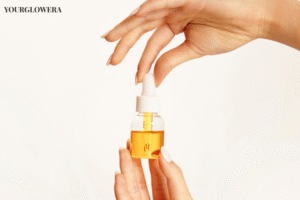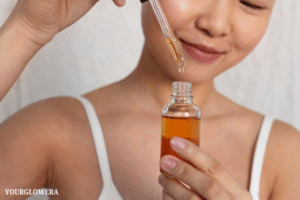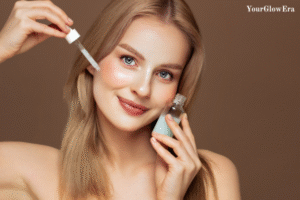Dealing with oily skin can often seem like a double-edged sword. While it often leads to natural moisture and a youthful glow, it can also result in clogged pores, acne, and an unwanted shiny appearance.
The key to glowing skin for oily skin types lies in balancing the oil production while maintaining that dewy, radiant look.
If you’re looking for glowing skin tips for oily skin, you’ve come to the right place.
This blog post will explore essential skincare tips, effective products, and simple lifestyle changes that can help you achieve a clear, glowing complexion without breaking the bank.
Table of Contents
1. Start with the Right Cleanser
A good skincare routine always begins with cleansing, and for oily skin, it’s crucial to choose a gentle, yet effective cleanser that removes excess oil without over-drying your skin. The right cleanser will leave your skin feeling fresh and clean, not tight or irritated.
• Look for gel-based or foaming cleansers: These formulas are ideal for oily skin as they help eliminate excess oil and impurities.
• Steer clear of harsh products containing alcohol: They can strip your skin’s natural oils, prompting it to produce excess oil to make up for the dryness.
• Consider salicylic acid cleansers: These can help prevent clogged pores and breakouts, keeping your skin smooth and clear.
A budget-friendly option to try is CeraVe Foaming Facial Cleanser or Neutrogena Oil-Free Acne Wash, which both offer deep cleansing without causing dryness.
2. Exfoliate Regularly but Gently
Exfoliation is essential for removing dead skin cells and preventing clogged pores, a common issue for those with oily skin.
However, it’s important not to over-exfoliate, as doing so can irritate your skin and actually stimulate it to produce more oil.
• Use a gentle exfoliator 2-3 times a week: Look for exfoliators with fine, non-abrasive particles to avoid irritating your skin.
• Chemical exfoliants are a great choice: Products with salicylic acid or glycolic acid can help keep pores clear and improve skin texture without being harsh.
Some budget-friendly exfoliators include The Ordinary Glycolic Acid 7% Toning Solution or St. Ives Blackhead Clearing Scrub.
3. Hydrate Your Skin Regardless of Oiliness
A common misconception is that individuals with oily skin do not need to use moisturizer. In reality, even oily skin needs hydration to maintain a healthy balance.
Selecting an appropriate moisturizer can maintain your skin’s hydration while preventing excess shine, following glowing skin tips for oily skin.
Look for oil-free, lightweight formulas that won’t clog pores, ensuring your skin stays nourished without the greasy feel.
• Go for lightweight, oil-free moisturizers: Gel-based moisturizers are ideal for oily skin as they provide hydration without clogging pores.
• Look for non-comedogenic products: These products are formulated to avoid blocking pores, which is essential for oily skin.
A budget-friendly choice is Neutrogena Hydro Boost Water Gel, providing excellent hydration with a lightweight feel.
4. Use a Mattifying Primer for a Smooth Base
For individuals with oily skin, applying a mattifying primer can effectively help manage excess shine and oil production throughout the day.
This step is especially helpful if you’re applying makeup and want to keep your face looking fresh and shine-free for longer periods, as suggested in glowing skin tips for oily skin.
• Choose primers with mattifying ingredients like silica or kaolin clay.
• Avoid heavy primers that may clog pores.
A great option that won’t break the bank is the e.l.f. Poreless Putty Primer, which is lightweight, mattifying, and perfect for oily skin types.
5. Incorporate Sunscreen Into Your Routine
Protecting your skin from harmful UV rays is essential for all skin types, including oily skin.
Sunscreen not only prevents skin damage but also helps keep your skin healthy and glowing in the long run, following glowing skin tips for oily skin.
• Opt for oil-free, non-comedogenic sunscreens: These will provide protection without clogging your pores.
• Choose gel-based sunscreens: They are light in texture and penetrate swiftly, leaving no greasy film behind.
For a budget-friendly sunscreen, try La Roche-Posay Anthelios Clear Skin Dry Touch Sunscreen SPF 60 or Neutrogena Clear Face Oil-Free Sunscreen SPF 55.
6. Incorporate Face Masks for Oily Skin
Face masks can be a fun and relaxing way to enhance your skincare routine, and for oily skin, clay masks are a game changer.
Clay masks help absorb excess oil and impurities while promoting clear, glowing skin.
• For oily skin types, clay masks formulated with kaolin or bentonite clay are most effective.
• Apply a face mask weekly to help keep your skin soft, clear, and well-balanced.
Cost-effective and effective options include Aztec Secret Indian Healing Clay along with the Freeman Facial Charcoal and Black Sugar Polish Mask, as recommended in glowing skin tips for oily skin.
7. Support healthy skin by maintaining a nutritious diet and staying well-hydrated
While skincare products can help, glowing skin starts from within. Your nutrition significantly influences the appearance and texture of your skin.
• Incorporate fruits and vegetables: Foods rich in antioxidants, vitamins C and E, and Omega-3 fatty acids can help nourish your skin from the inside.
• Avoid greasy foods and excess sugar: These can contribute to increased oil production and breakouts.
• Consume plenty amounts of water: Keeping yourself hydrated supports your skin’s firmness and healthy radiance, as part of glowing skin tips for oily skin.
8. Adopt a Consistent Skincare Routine
The most important glowing skin tip for oily skin is consistency. Stick to your skincare routine, including cleansing, moisturizing, and sun protection, and give products time to work.
It might take a few weeks to notice visible improvements, but with patience, your skin will thank you.
• Be patient: Don’t expect overnight results. Consistency is key for long-term, glowing skin.
• Track your progress: Keeping a skincare journal can help you stay on track and notice what products and habits work best for you.
9. Avoid Touching Your Face
Consistently placing your hands on your face can transfer oils and germs, which may cause pore congestion and skin breakouts, following glowing skin tips for oily skin.
Try to develop a habit of refraining from touching your face unless it’s unavoidable.
• Wash your hands regularly: This helps reduce the transfer of oils and dirt to your skin.
• Avoid resting your face on your hands or phone: Your phone can harbor bacteria, which can transfer to your face.
10. Be Mindful of Stress
Stress can elevate oil levels and lead to acne flare-ups, making it more difficult to achieve a radiant skin appearance, according to glowing skin tips for oily skin.
Managing stress through activities like meditation, yoga, or even taking short walks can help keep your skin looking clear and radiant.
• Practice stress-reducing techniques: Deep breathing, mindfulness, and regular exercise can help balance your body and mind.
• Prioritize sleep: A good night’s sleep helps the skin repair and regenerate.
Skipping Cleansing
One of the most common mistakes people make in their skincare routine is skipping the cleansing step.
After a long day, your skin accumulates makeup, dirt, sweat, and pollutants, all of which can clog pores and cause breakouts if left on overnight, as suggested in glowing skin tips for oily skin.
Cleansing removes impurities from your skin, helping your other skincare products perform at their best.
Why Cleansing is Essential:
• Removes makeup, dirt, oil, and pollutants that accumulate throughout the day.
• Enhances your skin’s receptivity for more effective absorption of serums, moisturizers, and treatments.
Budget-Friendly Recommendation: CeraVe Hydrating Cleanser is a gentle option for all skin types, and it helps maintain your skin’s moisture while cleansing.
Neglecting the Eye Area
The skin around your eyes is delicate and thinner than the rest of your face, making it more prone to fine lines, puffiness, and dark circles, as noted in glowing skin tips for oily skin.
Many people neglect their eye area or use the wrong products, leading to dryness and irritation.
Why You Need Eye Cream:
• Eye creams are formulated to target specific concerns like puffiness, dark circles, and fine lines.
• The sensitive skin surrounding the eyes needs gentle treatment and adequate moisture.
Common Mistake:
• Using your regular face moisturizer around the eyes.
• Skipping eye cream altogether.
How to Fix It:
• Invest in a separate eye cream that’s designed for the delicate eye area.
• Gently pat the cream onto the skin using your ring finger, as it applies the lightest pressure.
Affordable Choice: Cetaphil Hydrating Eye Gel-Ceam is a soothing, budget-friendly option that helps diminish puffiness and brighten dark circles.
Using Too Many Actives
Active ingredients like retinol, vitamin C, and AHAs can work wonders for your skin, but using too many of them at once can lead to irritation, redness, or dryness.
It’s important to introduce active ingredients gradually and pair them wisely to avoid overloading your skin, following glowing skin tips for oily skin.
Why Using Too Many Actives Is a Mistake:
• Using multiple potent actives can overwhelm your skin, leading to irritation and sensitivity.
• Some actives may not work well together, reducing their effectiveness.
• For instance, incorporate vitamin C into your morning routine and retinol into your nightly skincare.
Budget-Friendly Recommendation: The Ordinary Retinol 0.5% in Squalane is a gentle yet effective retinol that works well for most skin types.
Incorrect Layering of Products
The sequence in which you use your skincare products is important. Applying them incorrectly can result in reduced efficacy and poor absorption.
If you’re layering products in the wrong order, some active ingredients may not penetrate the skin properly, leading to suboptimal results, according to glowing skin tips for oily skin.
Why Product Layering Matters:
• Skincare products work best when applied from the thinnest to the thickest consistency.
• Applying products in the wrong order can prevent ingredients from absorbing properly and reduce their effectiveness.
Common Mistake:
• Using heavier creams such as moisturizers prior to applying serums.
• Giving precedence to the use of water-based formulations prior to the application of oil-based formulations.
How to Fix It:
• Apply your products in this order: Cleanser → Toner (if used) → Serums → Treatments → Moisturizer.
• Always apply lighter, water-based products first and heavier, oil-based products last.
Budget-Friendly Recommendation: The Ordinary Niacinamide 10% + Zinc 1% is a great lightweight serum that should be applied after cleansing and toning.
Conclusion:
Achieving glowing skin with oily skin can be a challenging task, but with the right approach, it’s absolutely possible!
By following these glowing skin tips for oily skin, you can create a balanced skincare routine that works for you.
From choosing the right cleanser to moisturizing, protecting your skin with sunscreen, and adopting healthy habits, glowing skin tips for oily skin will help you maintain a radiant, clear complexion without breaking the bank.
Remember, consistency is key. Stick to your routine, be patient, and in time, you’ll notice significant improvements in your skin’s appearance. Best of luck on your journey to glowing, beautiful skin!
Struggling with excess oil and looking for a way to achieve a healthy, glowing complexion? “Glowing Skin Tips for Oily Skin: The Ultimate Guide to a Healthy, Oil-Free Glow“, offers expert advice on how to control oil production while still keeping your skin glowing.
We’ll show you how oil-free doesn’t mean dull—learn how to nourish your skin without overloading it with oil. With the right skincare routine, following glowing skin tips for oily skin, you can enjoy a healthy, luminous glow without the shine. Read out our full guide to discover the ultimate tips for achieving an oil-free healthy glow.
Frequently Asked Questions
Which facewash is best for oily skin?
Look for a gentle, oil-free facewash that contains salicylic acid or glycolic acid to help control excess oil. Brands like Cetaphil, Neutrogena, and La Roche-Posay offer excellent options for oily skin, as recommended in glowing skin tips for oily skin.
How to get fair skin?
Fair skin can be achieved through good skincare practices, such as cleansing, exfoliating, moisturizing, and using sunscreen. Vitamin C serums and products with niacinamide can help brighten the complexion over time, following glowing skin tips for oily skin.
Is rose water good for oily skin?
Yes, rose water is great for oily skin. It has anti-inflammatory properties and helps balance oil production while soothing and hydrating the skin. It also works well as a toner, following glowing skin tips for oily skin.
Why is my skin so oily?
Oily skin is typically caused by overactive sebaceous glands, as explained in glowing skin tips for oily skin. Genetics, hormones, and environmental factors such as weather can all contribute to excessive oil production.
Is aloe vera good for oily skin?
Aloe vera is soothing and moisturizing without being greasy, making it an excellent option for oily skin, as suggested in glowing skin tips for oily skin. It can help reduce inflammation and redness caused by acne or irritation.
How to have beautiful skin?
Beautiful skin starts with a proper skincare routine—cleanse, exfoliate, hydrate, and protect, as part of glowing skin tips for oily skin. Drinking plenty of water, eating a balanced diet, and getting enough sleep also contribute to overall skin health.
How to stop oily hands?
To stop oily hands, wash them regularly with an oil-free soap, and apply a non-greasy, oil-free moisturizer to keep your skin hydrated, following glowing skin tips for oily skin. Avoid touching your face or other areas to prevent oil transfer.
Can I rub ice on my face daily?
Ice can be used on the face to reduce puffiness and inflammation, but it should not be used daily as it can irritate the skin. Apply ice in moderation for 2–3 minutes for best results, as recommended in glowing skin tips for oily skin.
Which moisturizer is best for oily skin?
The best moisturizer for oily skin is one that is lightweight, oil-free, and non-comedogenic, following glowing skin tips for oily skin. Gel-based moisturizers with ingredients like hyaluronic acid or glycerin are great choices.
How to reduce acne?
To reduce acne, use non-comedogenic products, keep your skin clean, and use acne treatment products with benzoyl peroxide or salicylic acid. Avoid touching your face and picking at pimples, as part of glowing skin tips for oily skin.









Leave a reply